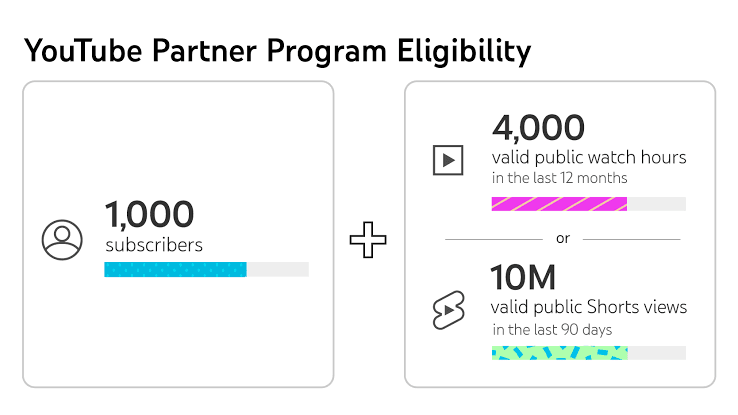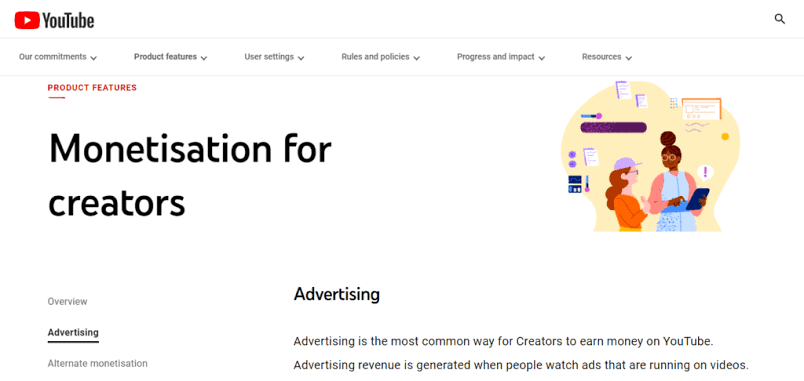YouTube has transformed from a video-sharing platform into a thriving ecosystem that supports millions of creators worldwide. As the second-largest search engine globally, YouTube offers massive reach and the potential to turn content creation into a full-time income. For aspiring and established creators alike, understanding how YouTube pays is essential for maximizing earnings and sustainability. Whether it’s through ad revenue, memberships, or sponsorships, YouTube provides multiple income opportunities, each with its own conditions and benefits.
This guide breaks down everything you need to know about how YouTube pays its creators.
Eligibility for YouTube Monetization:
To begin earning directly from YouTube, creators must join the YouTube Partner Program (YPP). Here’s a breakdown of the core eligibility criteria:
- 1,000 subscribers: You must have at least 1,000 subscribers on your channel.
- 4,000 watch hours or 10M Shorts views: Your content needs to accumulate 4,000 valid public watch hours in the last 12 months or 10 million public Shorts views in the past 90 days.
- AdSense account: You must link an approved Google AdSense account to receive payments.
- Policy compliance: Your channel must follow all of YouTube’s monetization policies, community guidelines, and content rules.

Without meeting these requirements, monetizing content on YouTube is not possible. Once accepted into YPP, a creator can unlock multiple revenue streams offered by the platform.
Main Sources of YouTube Revenue for Creators:
Let’s dive into the main sources of revenue for YouTube creators, where content meets creativity and earnings follow every engaging view.
1. Ad Revenue:
When people think about YouTube income, they usually picture ad revenue. This is YouTube’s primary monetization method for most creators.
YouTube places different types of ads on eligible videos:
- Pre-roll ads (before the video)
- Mid-roll ads (during longer videos)
- Display and overlay ads (next to or on the video)
Advertisers pay YouTube to show these ads, and YouTube shares the revenue with creators. The revenue model is based on two metrics:
- CPM (Cost Per Mille): What advertisers pay for 1,000 ad views.
- CPC (Cost Per Click): Revenue generated when viewers click on ads.
Creators receive 55% of the ad revenue generated, while YouTube keeps 45%. The actual earnings depend on content category, viewer location, and audience engagement. For example, finance and tech channels often see higher CPMs than entertainment or lifestyle content.
2. Channel Memberships:
In addition to ads, creators can earn through channel memberships. This feature allows fans to pay a recurring monthly fee to access exclusive perks. These perks can include:
- Custom badges and emojis
- Members-only videos or live chats
- Behind-the-scenes content
To unlock memberships, your channel must:
- Have over 1,000 subscribers
- Be part of the YPP
- Not made for kids or contain reused content
Channel memberships offer a reliable income stream that doesn’t rely on ad views. It strengthens community connection and rewards loyal viewers with exclusive access. This recurring revenue helps creators maintain financial stability, especially during low CPM periods or demonetization issues.
3. Super Chat and Super Stickers:
During live streams and premieres, viewers can directly support creators using Super Chat and Super Stickers. These features let fans pay to highlight their messages or send animated images in the live chat. The more a fan pays, the longer and more prominently their message is displayed. Super Chat is ideal for creators who regularly host live Q&As, gaming sessions, or interactive discussions.
Super Stickers, on the other hand, are animated graphics that fans can purchase and send during live streams as a form of appreciation.
To access these features, creators must:
- Be part of the YPP
- Be in a supported country
- Have a non made for kids channel
These tools not only boost income but also enhance viewer engagement and loyalty during live interactions.
4. YouTube Premium Revenue:
In an evolving digital landscape where user experience is key, YouTube Premium offers creators a unique revenue stream beyond traditional ads. This subscription-based model not only enhances viewer satisfaction with ad-free content but also ensures that creators are fairly rewarded for their content engagement even when ads aren’t shown. It’s an often overlooked yet valuable source of steady income for creators of all sizes.
- Earnings Model: Creators earn a share of the Premium subscription revenue based on how much time subscribers spend watching their videos.
- View Time Matters: The more Premium users watch your content, the more you earn regardless of ad performance.
- Bypasses Ad Blockers: Premium revenue is not affected by ad-blocking tools, ensuring fair payment for content.
- Consistent Income Source: It offers creators a stable, passive income stream alongside ad revenue and other monetization tools.
- No Need for Ads: Even if ads don’t appear, you’re still paid for engagement by Premium members.
YouTube Premium may not generate massive earnings alone, but it contributes to a more balanced and diversified income model for creators.
5. YouTube Shorts Fund and Shorts Monetization:
With the explosion of short form content, YouTube introduced the YouTube Shorts Fund and later transitioned into ad-based Shorts monetization. Initially, Shorts creators were rewarded from a fixed fund based on views and engagement. However, from 2023 onwards, YouTube started sharing ad revenue generated between Shorts content.
- Creators get a percentage of revenue from ads shown between Shorts in the feed.
- The split considers total views from all eligible Shorts during a time period.
- A portion of revenue is allocated to cover music licensing costs if copyrighted audio is used.
This system rewards consistent creators and encourages the production of high-quality, engaging short videos. It reflects YouTube’s push to compete with platforms like TikTok.

Alternative Monetization Methods on YouTube:
While YouTube’s built-in features are valuable, many creators earn a significant portion of their income through off-platform methods:
- Affiliate Marketing: Creators promote products and earn a commission for every sale made through their unique links. It’s popular in the tech, beauty, and lifestyle niche.
- Brand Deals & Sponsorships: Companies pay creators to feature products or services in their videos. Rates vary based on niche, views, and influencer reach.
- Merchandise Shelf: YouTube allows integration with merchandise providers like Teespring. Eligible creators can sell custom merchandise directly from their channel page.
- Crowdfunding (Patreon, Buy Me a Coffee): Supporters can donate or subscribe monthly for exclusive content or early access.
These streams help creators diversify income and reduce dependency on fluctuating ad revenue.
How Are Payments Processed From YouTube?
Once revenue is earned, YouTube pays through your linked Google AdSense account. Here’s how the payment system works:
- Threshold: You need a minimum balance of $100 to receive a payout.
- Verification: Your address and bank details must be verified before payment processing.
- Schedule: Payments are typically issued between the 21st and 26th of each month.
- Delays: Payments may be delayed if earnings don’t meet the threshold or if account issues arise.
Accurate and up-to-date AdSense information ensures smooth and timely transactions. Monitoring earnings regularly helps track progress and plan ahead financially.
Factors That Affect Earnings:
Earnings vary widely across creators. Multiple factors influence the final amount you receive:
- Audience Location: CPMs are higher in countries like the USA, Canada, and UK.
- Niche of Content: Finance, legal, and tech channels usually have higher CPMs compared to vlogs or comedy.
- Engagement Metrics: Longer watch times, higher click-through rates, and audience retention drive more revenue.
- Seasonal Trends: Holiday seasons (like December) often bring higher CPM due to increased ad spending by brands.
Understanding these variables helps creators tailor their content strategy for optimal earnings and long-term growth.
Tips to Maximize YouTube Revenue:
These are the Tips to maximize YouTube Revenue:
- Create Ad-Friendly Content: Avoid profanity, controversial topics, and copyrighted music.
- Engage Your Audience: Use compelling thumbnails and hooks to boost watch time.
- Consistency Matters: Regular uploads keep your audience active and improve channel growth.
- Diversify Income: Don’t rely solely on ads, explore memberships, affiliate links, and sponsorships.
Monetization success comes from combining creativity with strategy and consistency.
Conclusion:
YouTube offers a multi-faceted monetization system that allows creators to earn through ads, memberships, Super Chats, Shorts, and more. However, long-term success lies in creating engaging content, understanding your audience, and diversifying income sources. As the platform continues to evolve, so do the opportunities for creators ready to learn and adapt. If you’re passionate about creating videos and building a community, YouTube can become more than just a platform, it can be a career.
FAQs:
The pay varies by niche and audience location, but on average, creators earn between $1 to $5 per 1,000 views from ads.
Yes. YouTube income is considered taxable. Creators must report it according to their local tax laws.
Yes. You can earn through sponsorships, merchandise, memberships, affiliate marketing, and crowdfunding.
It depends on your content quality and consistency. Meeting YPP criteria can take weeks to months.
Not exactly. Shorts use a different revenue-sharing model based on ad revenue between videos, not direct ad placement.
